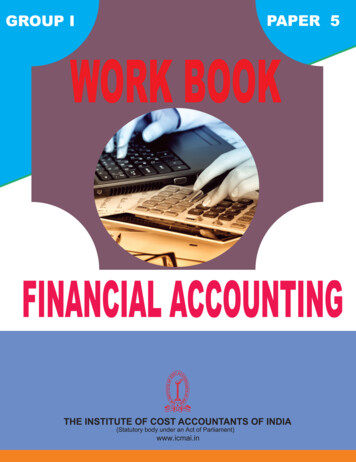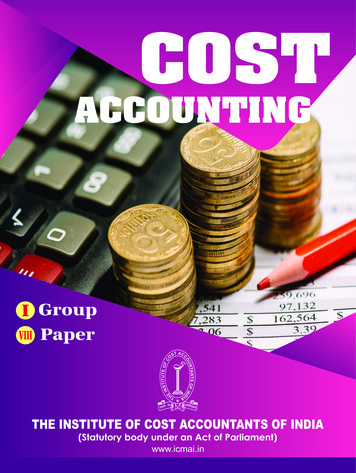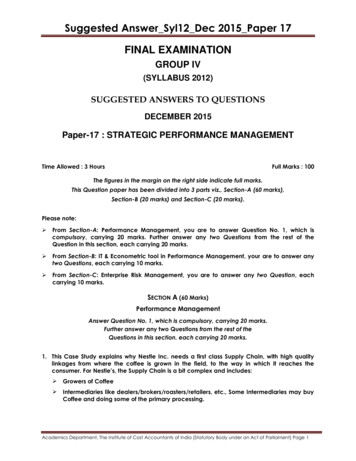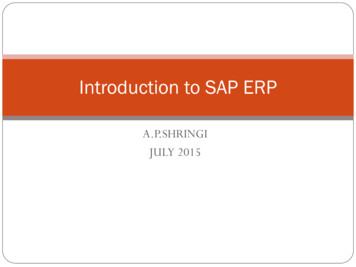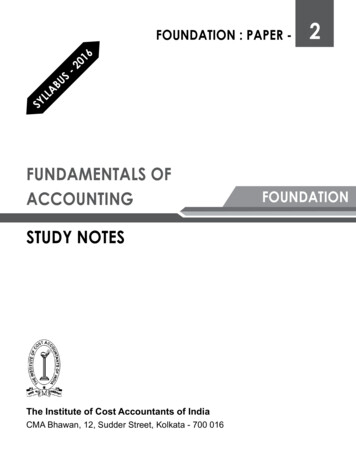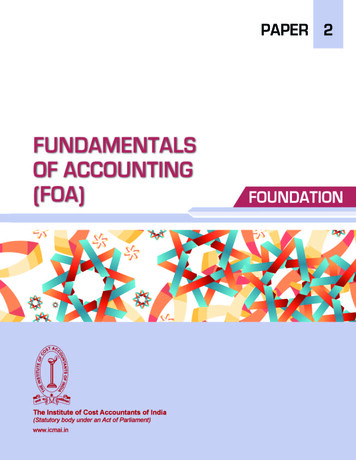
Transcription
FOUNDATION : PAPER -FUNDAMENTALS OFACCOUNTINGSTUDY NOTESThe Institute of Cost Accountants of IndiaCMA Bhawan,12, Sudder Street, Kolkata - 700 0162FOUNDATION
First Edition : January 2013Revised Edition : April 2013Second Edition : December 2014Published by :Directorate of StudiesThe Institute of Cost Accountants of India (ICAI)CMA Bhawan, 12, Sudder Street, Kolkata - 700 016www.icmai.inPrinted at :Repro India LimitedPlot No. 02, T.T.C. MIDC Industrial Area,Mahape, Navi Mumbai 400 709, India.Website : www.reproindialtd.comCopyright of these Study Notes is reserved by the Insitute of CostAccountants of India and prior permission from the Institute isnecessary for reproduction of the whole or any part thereof.
SyllabusPaper 2: Fundamentals of Accounting (FOA)Syllabus StructureAFundamentals of Financial Accounting60%BFundamentals of Cost & Management Accounting40%B40%A60%ASSESSMENT STRATEGYThere will be written examination paper of three hoursOBJECTIVESTo gain comprehensive understanding of all aspects relating to financial statements, principles,procedures of accounting and their application to different practical situationsLearning AimsThe Syllabus aims to test the student’s ability to:l Understandand explain the conceptual framework of Accountingl PrepareAccounts for various entities under different situationsl Acquirebasic concepts of Cost & Management Accounting relevant for managerial decisionmakingSkill sets requiredLevel A: Requiring the skill levels of knowledge and comprehensionSection A : Fundamentals of Financial Accounting1.2.3.4.5.Accounting ProcessReconciliation StatementAccounting for DepreciationPreparation of Final Accounts Accounting for Special Transactions60%
Section B: Fundamentals of Cost & Management Accounting40%6. Fundamentals of Cost Accounting7. Preparation of Cost Statements8. Fundamentals of Management Accounting – basic knowledge and itsapplicationSection A : Fundamentals of Financial Accounting [60 marks]1.Accounting Process(a) Theoretical Framework ( meaning, scope and usefulness of Accounting; Generally AcceptedAccounting Principles, Concepts and Conventions)(b) Capital and Revenue transactions- capital and revenue expenditures, capital and revenue receipts(c) Measurement, Valuation and Accounting estimates(d) Double entry system, Books of prime entry, Subsidiary Books(e) Recording of Cash and Bank transactions(f)Preparation of Ledger Accounts(g) Preparation of Trial Balance- interpretation and usefulness(h) Rectification of Errors(i) Opening entries, Transfer entries, Adjustment entries, Closing entries2.Reconciliation Statements(a) Bank Reconciliation Statement(b) Receivables / Payables Reconciliation Statement(c) Stock Reconciliation Statement3.Accounting for Depreciation(a) Depreciation Policy(b) Methods, computation and Accounting treatment4.Preparation of Final Accounts:(a) Of a Profit making concern (for sole proprietorship concern and partnership firm only)(i) Preparation of Trading Account, Profit & Loss Account and Balance Sheet(ii) Accounting treatment of bad debts, reserve for bad and doubtful debts, provision fordiscount on debtors and provision for discount on creditors(b) Of a Not-for-Profit making concern(i) Preparation of Receipts and Payments Account;(ii) Preparation of Income and Expenditure Account(iii) Preparation of Balance Sheet(c) Under Single Entry System including conversion of single entry into double entry system (basiclevel)(i) Concept of Single Entry System and preparation of Statement showing Profit and Loss ,Statement of Affairs(ii) Conversion of Single Entry System into Double Entry System of Accounting
5.Accounting for Special Transactions(a) Bills of Exchange(b) Consignment(c) Joint Venture(d) Sale of goods on approval or return basisSection B: Fundamentals of Cost & Management Accounting[40 marks]6.Fundamentals of Cost Accounting(a) Cost and Management Accounting – Generally Accepted Cost Accounting Principles(b) Accounting for Material cost (including Accounting of Inventory – LIFO, FIFO, Weighted AverageCost)(c) Accounting for Labour costs, Direct Expenses and Overheads7.Preparation of Cost Statements(a) Cost Data collection, Cost Sheet formats,(b) Preparation of Cost Sheets (historical cost sheets and estimated cost sheets)8.Fundamentals of Management Accounting(a) Marginal Costing and Break-even analysis – basic knowledge(b) Application of Marginal Costing for decision-making
ContentFUNDAMENTALS OF ACCOUNTINGStudy Note 1 : Accounting k-KeepingAccounting CycleBasic Accounting TermsGenerally Accepted Accounting PrinciplesAccounting Concepts and ConventionsEvents & TransactionsVoucherDouble Entry SystemThe Concepts of “Account”, “Debit” & “Credit”Types of AccountsThe Accounting ProcessAccounting EquationAccrual Basis & Cash Basis of AccountingCapital & Revenue TransactionAccounting StandardsDouble Entry System, Books of Prime Entry, Subsidiary BooksTrial 1.171.191.201.231.301.331.521.20Measurement, Valuation & Accounting Estimates1.601.21Opening entries, Closing entries, Transfer entries and Rectification entries1.75Study Note 2 : Reconciliation Statements2.12.22.3Bank ReconciliationReceivable ReconciliationPayable Reconciliation2.12.162.172.4Stock Reconciliation2.183.13.23.33.43.53.63.73.83.9Study Note 3 : Depreciation AccountingIntroductionCertain Usful TermsCauses of DepreciationCharacteristics of DepreciationObjective of and Necessity for providing DepreciationFactors to be Consider for Calculating the Actual DepreciationMethods of Charging DepreciationProvision for Depreciation AccountDisposal of an asset3.13.13.23.33.33.33.43.123.13
3.103.113.123.13Profit or Loss on sale of assets - Method of Depreciation CalculationChange of Method - Prospective and RetrospectiveApplication of AS 6 - Depreciation AccountingApplication of AS 10 - Accounting for Fixed Asset3.153.163.213.23Study Note 4 : Preparation of Final Accounts4.14.24.34.44.5IntroductionPreparation of Financial StatementsBad DebtsPreparation of Financial Statement of Non-Trading ConcernPreparation of Financial Statement under Single Entry Systemincluding Conversion of Single Entry into Double Entry System4.14.14.354.484.72Study Note 5 : Accounting for Special Transactions5.15.25.35.4Bill of ExchangesConsignment AccountingJoint Venture AccountsSales of goods on approval or return basis5.15.265.415.54Study Note 6 : Fundamentals of Cost rally Accepted Cost Accounting Principles (GACAP) &Cost Accounting Standards (CASs)DefinitionsMethods of CostingCost & Cost ObjectCost OrganizationCosting SystemCost Determination6.16.26.146.176.196.256.266.26Study Note 7 : Preparation of Cost Statements7.17.27.37.4Cost Statements - IntroductionCost AccumulationCost CollectionCost Sheet Formats & Preparation7.17.17.27.3Study Note 8 : Fundamentals of Management Accounting8.18.28.38.48.5Marginal Costing-IntroductionConcept of Contribution, P/V Ratio and Break-Even PointConcept of Margin Of Safety (MOS)Cost - Volume - Profit Relationship (CVP Analysis)Application of Marginal Costing for Decision Making8.18.38.48.58.7
Study Note - 1ACCOUNTING PROCESSThis Study Note itionsBook-KeepingAccounting CycleBasic Accounting TermsGenerally Accepted Accounting PrinciplesAccounting Concepts and ConventionsEvents and TransactionsVoucherDouble Entry SystemThe Concepts of “Account”, “Debit” and “Credit”Types of AccountsThe Accounting ProcessAccounting EquationAccrual Basis & Cash Basis of AccountingCapital & Revenue TransactionsAccounting StandardsDouble Entry System, Books of Prime Entry, Subsidiary BooksTrial BalanceMeasurement, Valuation & Accounting EstimatesOpening entries, Closing entries, Transfer entries and Rectification entries1.1 INTRODUCTIONBusiness is an economic activity undertaken with the motive of earning profits and to maximize thewealth for the owners. Business cannot run in isolation. Largely, the business activity is carried out bypeople coming together with a purpose to serve a common cause. This team is often referred to as anorganization, which could be in different forms such as sole proprietorship, partnership, body corporateetc. The rules of business are based on general principles of trade, social values, and statutory frameworkencompassing national or international boundaries. While these variables could be different for differentbusinesses, different countries etc., the basic purpose is to add value to a product or service to satisfycustomer demand.The business activities require resources (which are limited & have multiple uses) primarily in terms ofmaterial, labour, machineries, factories and other services. The success of business depends on howefficiently and effectively these resources are managed. Therefore, there is a need to ensure thebusinessman tracks the use of these resources. The resources are not free and thus one must be carefulto keep an eye on cost of acquiring them as well.As the basic purpose of business is to make profit, one must keep an ongoing track of the activitiesundertaken in course of business. Two basic questions would have to be answered:(a) What is the result of business operations? This will be answered by finding out whether it has madeprofit or loss.(b) What is the position of the resources acquired and used for business purpose? How are theseresources financed? Where the funds come from?The answers to these questions are to be found continuously and the best way to find them is to record allthe business activities. Recording of business activities has to be done in a scientific manner so that theyreveal correct outcome. The science of book-keeping and accounting provides an effective solution. ItFUNDAMENTALS OF ACCOUNTING I 1.1
Accounting Processis a branch of social science. This study material aims at giving a platform to the students to understandbasic principles and concepts, which can be applied to accurately measure performance of business.After studying the various chapters included herein, the student should be able to apply the principles,rules, conventions and practices to different business situations like trading, manufacturing or service.1.2 DEFINITIONSDefinition of AccountingDefinition by the American Institute of Certified Public Accountants (Year 1961):“Accounting is the art of recording, classifying and summarizing in a significant manner and in terms ofmoney, transactions and events which are, in part at least, of a financial character, and interpretingthe result thereof”.Definition by the American Accounting Association (Year 1966):“The process of identifying, measuring and communicating economic information to permit informedjudgments and decisions by the users of accounting”.(a) Objectives of Accounting(i) Providing Information to the Users for Rational Decision-makingThe primary objective of accounting is to provide useful information for decision-making tostakeholders such as owners, management, creditors, investors, etc. Various outcomes of businessactivities such as costs, prices, sales volume, value under ownership, return of investment, etc. aremeasured in the accounting process. All these accounting measurements are used by stakeholders(owners, investors, creditors/bankers, etc.) in course of business operation. Hence, accounting isidentified as ‘language of business’.(ii) Systematic Recording of TransactionsTo ensure reliability and precision for the accounting measurements, it is necessary to keep asystematic record of all financial transactions of a business enterprise which is ensured by bookkeeping. These financial records are classified, summarized and reposted in the form of accountingmeasurements to the users of accounting information i.e., stakeholder.(iii) Ascertainment of Results of above Transactions‘Profit/loss’ is a core accounting measurement. It is measured by preparing profit and loss accountfor a particular period. Various other accounting measurements such as different types of revenueexpenses and revenue incomes are considered for preparing this profit and loss account. Differencebetween these revenue incomes and revenue expenses is known as result of business transactionsidentified as profit/loss. As this measure is used very frequently by stockholders for rational decisionmaking, it has become the objective of accounting.For example, Income Tax Act requires that every business should have an accounting systemthat can measure taxable income of business and also explain nature and source of every itemreported in Income Tax Return.(iv) Ascertain the Financial Position of Business‘Financial position’ is another core accounting measurement. Financial position is identified bypreparing a statement of ownership i.e., Assets and Owings i.e., liabilities of the business as ona certain date. This statement is popularly known as balance sheet. Various other accountingmeasurements such as different types of assets and different types of liabilities as existed at aparticular date are considered for preparing the balance sheet. This statement may be used byvarious stakeholders for financing and investment decision.1.2 I FUNDAMENTALS OF ACCOUNTING
(v) To Know the Solvency PositionBalance sheet and profit and loss account prepared as above give useful information tostockholders regarding concerns potential to meet its obligations in the short run as well as in thelong run.Providing Information to the Users for RationalDecision-makingSystematic Recording of TransactionsAscertainment of Results of above TransactionsAscertain the Financial Position of BusinessTo Know the Solvency PositionFunction of AccountingThe main functions of accounting are as follows:(a) Measurement: Accou
1.14 Accounting Equation 1.19 1.15 Accrual Basis & Cash Basis of Accounting 1.20 1.16 Capital & Revenue Transaction 1.23 1.17 Accounting Standards 1.30 1.18 Double Entry System, Books of Prime Entry, Subsidiary Books 1.33 1.19 Trial Balance 1.52 1.20 Measurement, Valuation & Accounting Estimates 1.60 1.21 Opening entries, Closing entries, Transfer entries and Rectification entries 1.75

